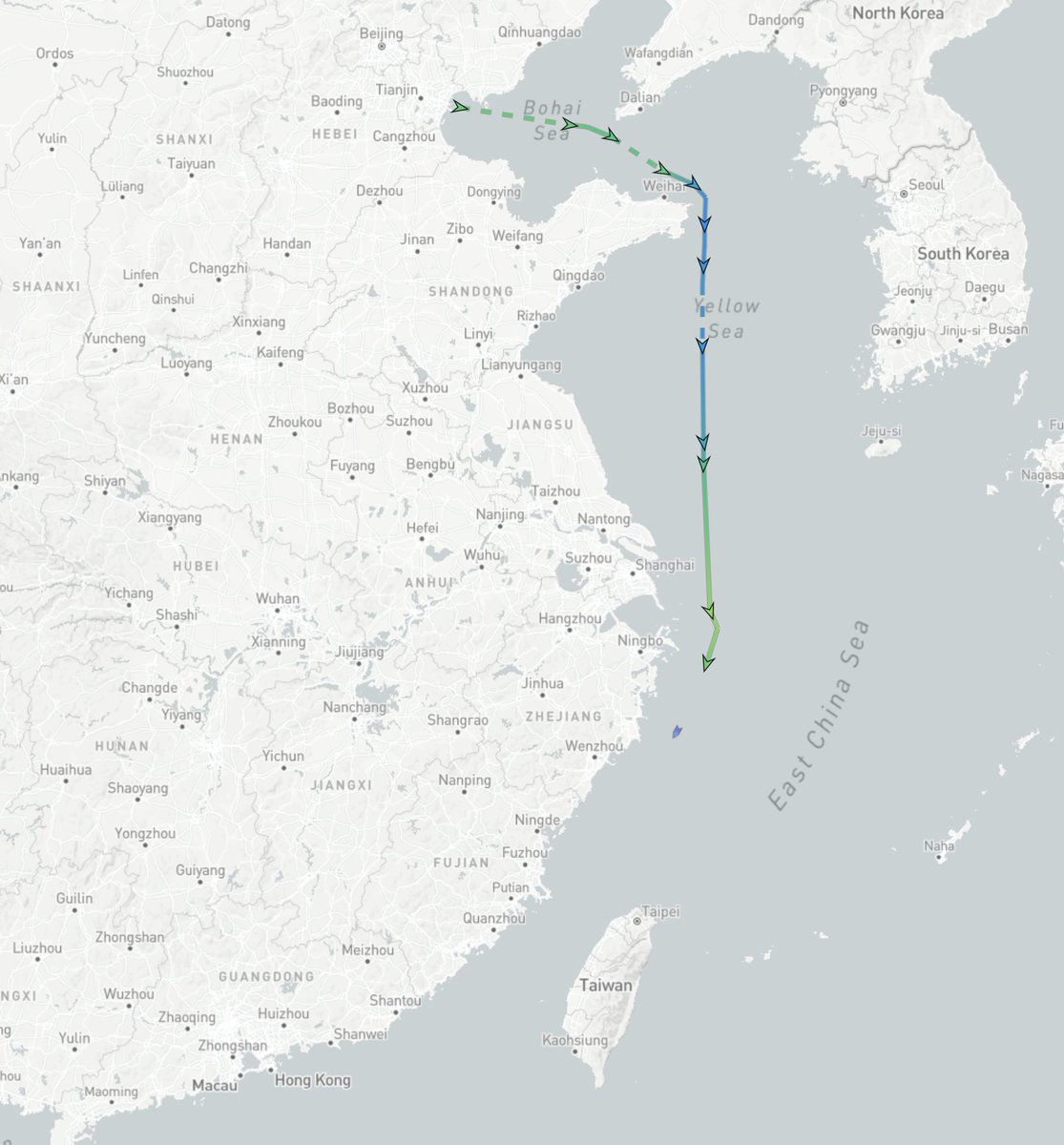
Some folks may recall this article I wrote last year in @WarOnTheRocks on how the PRC could use civilian shipping—and especially roll-on/roll-off ferries & vehicle carriers—to augment traditional PLA Navy amphibious sealift capacity in a Taiwan invasion. warontherocks.com/2021/08/mind-t…
Since it's been roughly a year since I conducted the survey of Chinese-owned Ro-Ro ferries and vehicle carriers that supplied the key data to the article, I thought it might be useful to do such a survey again and see how things have changed over the last year or so.
Once again I used Automatic Information System (AIS) data from @MarineTraffic, only counting vessels in active use—either broadcasting AIS data in real-time or having done so within the last few weeks. marinetraffic.com/en/ais/home/ce…
First, let's recap the key numbers from 2021's data: compared to the PLA Navy's ~370K displacement tonnes of amphibious assault ships, I found roughly 750K tonnes of civilian Ro-Ro ferries (see left) and about 425K tonnes of vehicle carriers (right): roughly 3X the PLAN's total. 


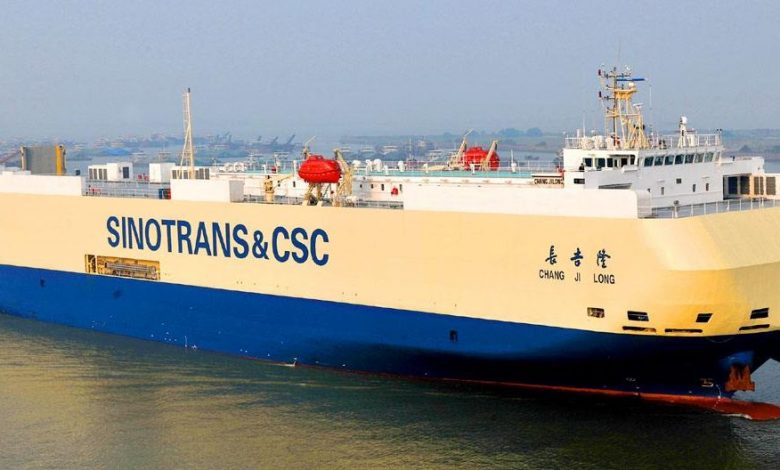
In addition to these 1.1M tonnes of PRC-owned Ro-Ros, I also found ~370K more tonnes of Hong Kong-owned (usually Panama-flagged) vehicle carriers. One could debate whether these would be available for PLA use in a conflict, but I think the answer is a definite "maybe". 
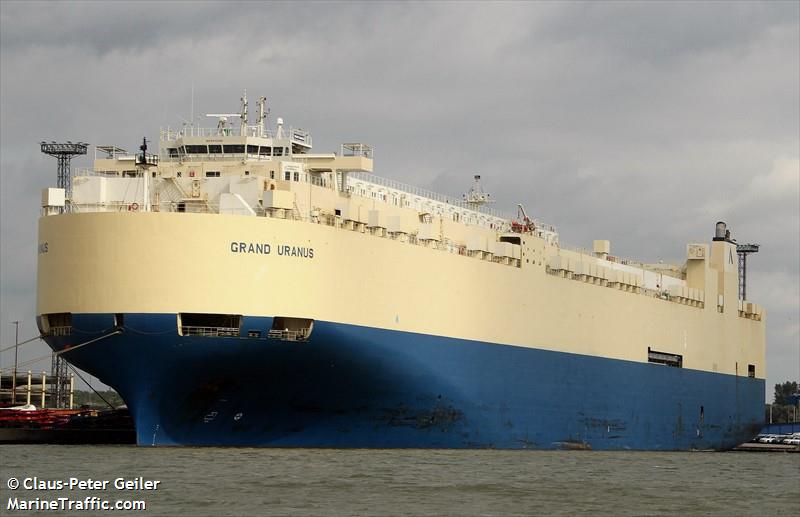
So, to 2022's new data: first up, Ro-Ro ferries.
Last year's total of ~750K tonnes went up to ~900K, a jump of about 150K. While 35K was from 3 new ferries, most of it was from ferries I just didn't catch last time, & did this time (better search tools?). bairdmaritime.com/work-boat-worl…
Last year's total of ~750K tonnes went up to ~900K, a jump of about 150K. While 35K was from 3 new ferries, most of it was from ferries I just didn't catch last time, & did this time (better search tools?). bairdmaritime.com/work-boat-worl…
Next: PRC-owned vehicle carriers, where the total went from about 425K to ~450K, an increase of about 25K tonnes. Most of it (18K) was due to 1 new vessel, with the rest due mostly to using more accurate vessel draft data (max instead of current draft). en.coscoshipping.com/art/2022/7/28/…
The whopper of an increase was in HK-owned vehicle carriers. Last year's ~370K tonnes went way up to ~940K, an increase of about 570K. None of the new additions were new-builds, so I just don't know why I didn't see them last year—better search, or maybe changes in ownership? 🤷♂️
Overall, these increases took the total of PRC-owned Ro-Ros from 2021's ~1.17M tonnes to roughly ~1.35M, an increase of about 250K tonnes (again, compared to the PLA Navy's 370K tonnes of amphibs). The grand total of ~1.5M tonnes of PRC+HK Ro-Ros went up to ~2.3M tonnes (+~750K).
With all this in mind, I'll now take a stab at something I didn't tackle in last year's article - just how much *stuff* (mainly, vehicles and soldiers) could these civilian Ro-Ros deliver in support of a Taiwan invasion? This'll take some doing, even for a first-order estimate.
The issue here are that it isn't like the PRC tells us how many combat vehicles each type of ferry can carry, or for that matter how many vehicles are in a typical PLA Combined Arms Brigade (the basic unit of the PLA today). So, some approximations & conversions are in order.
I may go through the process in detail in an “appendix” later, but basically it was a matter of figuring out an average of how many “lane-meters” of vehicle storage a typical ferry has per deadweight ton (load-carrying capacity), multiplying by DWT for selected ferries…
…then converting those lane-meters to sq ft. For vehicle carriers, I did a similar process but for CEUs (car equivalent units), again ending up with a square footage of vehicle capacity.
This is probably a good point to provide an example of how good China’s ferries are at providing that square footage of vehicle stowage compared to a traditional amphibious assault ship. After all, as I said in the article, that’s what they’re built for! 
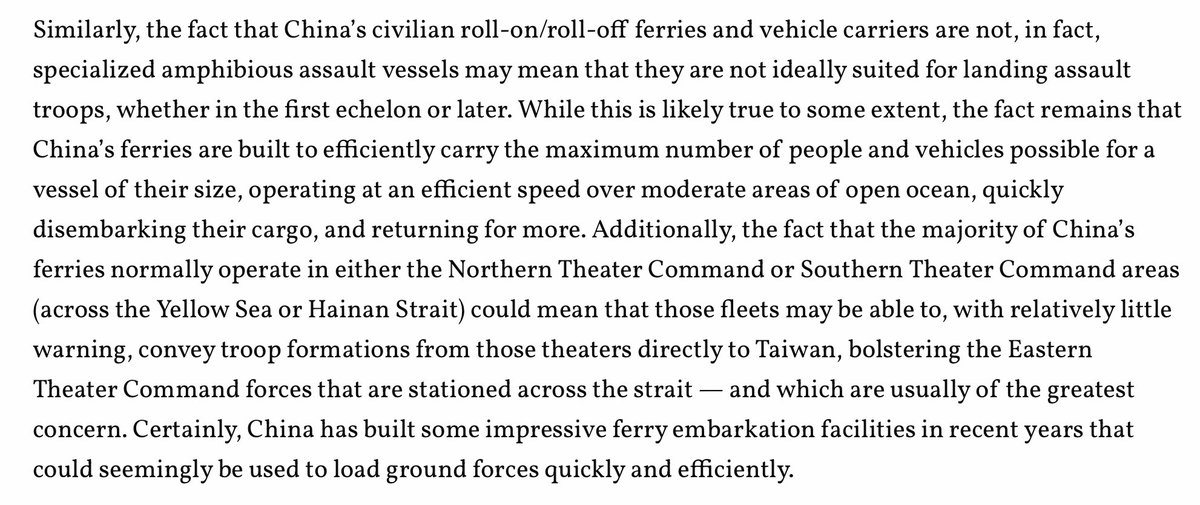
A specific example: one main class of USN amphibs is the San Antonio Class LPD. It’s a 25K displacement ton ship. Purpose-built & versatile, it can launch helos, hovercraft, landing craft, etc. It has 20K sq ft of vehicle storage & can carry 800 marines. navsea.navy.mil/Home/Team-Ship…
Here is China’s newest Ro-Ro ferry, the Xiang Long Dao. By my calculations, it’s a roughly 23K ton ship. In addition to carrying 1300+ people, it has about 60K sq ft of vehicle stowage - 3X the larger San Antonio LPD. Again, that’s what it’s optimized for. bairdmaritime.com/work-boat-worl…
Getting back to what this means in aggregate: to figure out how much oomph could be delivered, I selected ferries most likely to be used in an invasion - those operated by companies known to be organized as auxiliaries of the PLA or whose ferries have been observed in exercises.
These 34 ferries totaled about 440K displacement tons of shipping. Converting their deadweight tons to sq feet of vehicle storage, this resulted in ~1.8M aggregate sq ft of vehicle capacity per trip, whether delivered straight to the beach or to a pier. news.usni.org/2021/07/26/chi…
Switching over to vehicle carriers, I again counted vessels owned by companies known to be organized maritime militia units, or whose ships have participated in exercises. Using a similar conversion, these ships could deliver ~3.6M sq ft of stuff per trip, though only to piers.
So, you may be wondering - is that a lot? How many sq ft of stuff does it take to deliver a PLA brigade? The short answer is…🤷♂️.
But…apparently a PLA CAB is roughly equivalent to a US Army Brigade Combat Team (BCT), and we CAN figure out about how many sq ft one of those takes.
But…apparently a PLA CAB is roughly equivalent to a US Army Brigade Combat Team (BCT), and we CAN figure out about how many sq ft one of those takes.

I found a pamphlet that provides sealift requirements for various Army brigades, including for example a Heavy Brigade Combat Team (yes, Army folks, I know the BCTs have changed since, but I’m sure it’s close enough for Twitter). Looks like an HBCT required 338K sq feet… 
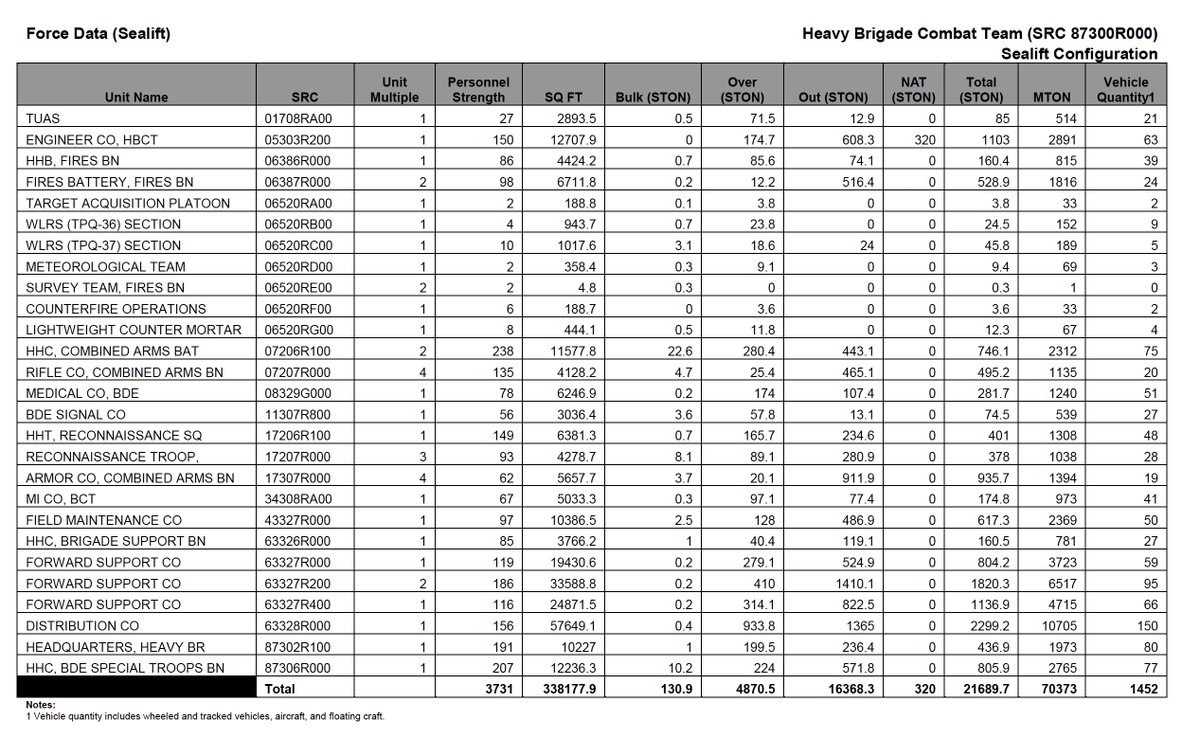
…and its accompanying “supply and ammunition” requires about 265K sq ft for “high optempo” operations, though I don’t know how many days worth that is (presumably enough to start an invasion and seize a lodgment somewhere like Taiwan). 

So, going back to our 1.8M sq ft of ferry capacity, and then applying a 25% reduction (a “stowage factor” to account for gaps and unused space), the resulting 1.36M sq ft of capacity should be by my calculations enough to deliver roughly 4 PLA brigades, per trip. 
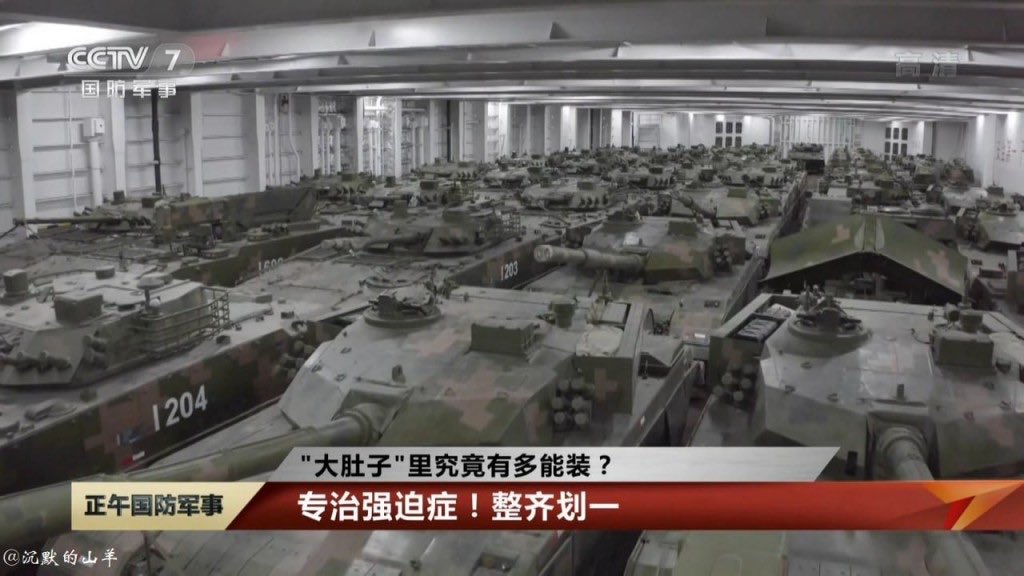
Adding in the vehicle carrier sq feet with a similar factor, and then assuming its gets used for supplies and ammunition that accompany the brigades, that would be almost 7 brigades worth of equipment—plus their supplies and ammunition—per trip, between them and the ferries.
In terms of how much force those fleets could deliver over time, let’s make some more rough assumptions: the Strait is roughly 120 nm across, & let’s say a ferry averages about 12 knots. That’s about 10 hrs each way, so let’s say with loading/unloading that’s ~1 trip per day.
For the vehicle carriers, let’s say it takes longer to load/unload, so maybe 2 days per round trip. If you take the square feet for each type and do the math, that’s an average of ~2.7M sq ft delivered each day. With 600K required per brigade, w/ ammo + supplies, that ~4 per day.
For perspective, it looks to me like there are 31 BCTs in the whole US Army today, and many would take less sealift than the HBCTs in these calcs. At ~4 per day, it could take China’s Maritime Militia ferries & vehicle carriers about 8 days to deliver them all, with supplies. 😐
Bear in mind that this in *in addition to* what could be delivered via paradrop, helicopter-borne assault, and of course the PLA Navy’s traditional amphibious assault ships, which would probably lead the assault. 

Now, I’m sure that there may be factors I’m not considering here, and that long term sustainment of these forces would take a LOT more shipping than this. But I think it’s been a worthwhile exercise just to get a first-order approximation.
I’d welcome any comments from sealift experts (note: if you’re reading up on sealift right now…you’re not one) that may know factors that I’m not considering here. After all, this is not a published article, and is a bit of a test-drive. In any case, thanks for reading this far!
• • •
Missing some Tweet in this thread? You can try to
force a refresh


